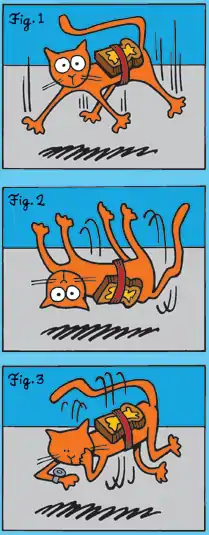Buttered cat paradox
The buttered cat paradox is a popular joke based on putting two adages (sayings) together to make them funny:
- Cats always land on their feet.
- Buttered toast always lands buttered side down.

The paradox happens when one asks this question: What would happen if one attached a piece of buttered toast (butter side up) to the back of a cat, then dropped the cat from a large height?
In reality
In reality, cats can turn themselves right side up in mid-air if they should fall upside-down. This is named the cat righting reflex. This reflex lets them land on their feet if dropped from high enough up (about 30 centimetres (12 inches)).[1] Toast, not being alive, does not have the ability to turn itself over. Nor does it want to, since it cannot think.
Toast usually lands on the floor butter-side-down. This is because of how it is dropped from a table. As the toast falls from the table, it rotates or turns. Using the average speed of rotation for a slice of toast as it falls from the table and the usual height of a table, a slice of toast that began butter-side-up on the table will land butter-side-down on the floor 81% of the time. This is because the buttered side is heavier. When an object has a heavy and light side, in most cases it will fall heavy side first.[2]
Domestic cats usually weigh between 4 and 5 kilograms (8.8 and 11.0 pounds).[3] A regular slice of bread weighs only one ounce and a pat of butter about one fourth ounce.[4] So attaching a very small piece of toast with butter to a much larger cat would hardly have any effect on how the cat would move.
References
- Nguyen, Huy D. (1998). "How does a Cat always land on its feet?". Georgia Institute of Technology, School of Medical Engineering. Archived from the original on 10 April 2001. Retrieved 6 December 2017.
- Nick McDermott (3 September 2013). "Why your toast falls butter side down". Daily Mail. Retrieved 6 December 2017.
- Carol Himsel Daly, Maine Coon Cats: A Complete Owner's Manual, OCLC 32388968, (Barron's, 1995), p. 11.
- American Medical Association, Today's Health (November 1957), OCLC 1605170 Vol, 35, page 25.